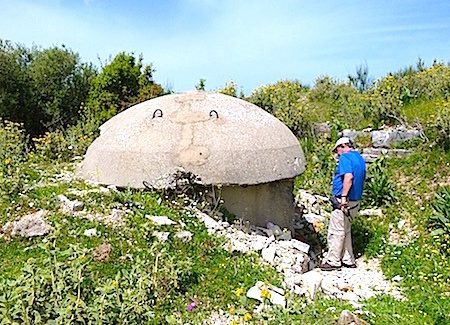Shore Excursion: Paranoid dictator builds thousands of concrete bunkers around Albania
By Jackie Sheckler Finch
Sprouting out of the Albanian hillside like a poisonous mushroom, the concrete bunker is one of the weirdest things I have ever seen. But, unbelievably, the story behind it is even more strange.
“A crazy dictator built the bunkers,” said M/V Athena cruise program director Antun Matičević. “He built almost 800,000 bunkers to protect Albania. They were never used and now they are protecting rocks.”
On our way drive through Albania, our tour bus took us past some gorgeous countryside. “It’s a beautiful country, like nature has blessed this region,” tour guide Demyr said.
We also saw great poverty, half-built projects, old Communist buildings, massive trash piles and signs that Albania is slowly beginning to recover from years of oppressive rulers.
At one point on our bus ride, Antun had the bus stop so we could go inside one of the bunkers to see how ridiculously small they are. Just a round concrete blob with a gun hole to kill whatever enemy was supposed to invade Albania.
For a bit of background, Albania is located on the eastern shore of the Adriatic Sea. About the size of Maryland, Albania has a population of almost 2.9 million.
“Mother Teresa was born in Albania,” Antun said. Born Aug. 26, 1910, Mother Teresa died Sept. 5, 1997, and is buried in India. Her native country has requested to have the saint’s body returned for burial next to her mother and sister in Albania’s capitol of Tirana but India is not agreeable.
The words of Mother Teresa herself could be used to settle the squabble. ‘‘By blood, I am Albanian. By citizenship, an Indian. By faith, I am a Catholic nun. As to my calling, I belong to the world,” she once said.
After World War II, Albania became a Stalinist state under Enver Hoxha, and remained staunchly isolationist until its transition to democracy after 1990. It was under Hoxha’s reign from 1944 until his death from diabetes in 1985 at the age of 76 that the bunkers were built.
“The country was already poor and so much money was wasted to build those useless bunkers,” Antun said. “Albania is the poorest country in Europe.”
The bunkers are located everywhere – city, country, beach, playgrounds, vineyards, even cemeteries. There is no escaping the invasive bunkers, roughly one for every four Albanians when the eyesores were constructed. The plan was for citizens to dash into the cement, iron and steel strongholds to defend themselves and their country when it was invaded.
“Hoxha was paranoid,” Antun said. “He had many enemies and always expected to be attacked.”
The fortifications never really had any military value even if Albania had been under siege. Who was going to supply the weapons for the Albanians to fight an invading enemy? Who was going to coordinate the fight? The bunkers were easily spotted from a chopper and could not withstand modern warfare.
The 1992 elections ended 47 years of Communist rule, but the latter half of the decade saw a quick turnover of presidents and prime ministers. Today, the bunkers still mar the landscape and are an inescapable reminder of a man many would rather forget.
An acute housing shortage after the fall of the Communist regime in 1990 led some Albanians to try and live in the abandoned bunkers. But lack of running water and sanitary conditions contaminated areas around the inhabited bunkers and the unhealthy arrangement was soon discontinued.
The bunkers also were said to be used by romantic Albanian teens who didn’t have access to automobiles as their American counterparts did. In 2009, a powerful Soviet-era type tank was brought in to roll over beach bunkers that were threatening people. Several swimmers had drowned in whirlpools created by streams around the bulky bunkers. But there are still thousands and thousands of bunkers left.
Photo by Jackie Sheckler Finch















View Recent Comments